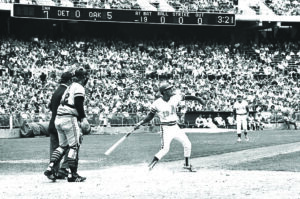By David Mullen
On September 26, the Texas Rangers continued to wind down a frustrating season with an afternoon game against the Athletics at the Oakland Coliseum. For the Rangers, it was just another game on the schedule. For the A’s and their loyal fans, it was the end of an era.

Photo courtesy of MLB
The Oakland Coliseum was the “Home of Champions” as an entrance sign stated. The A’s marketed the team as “Rooted in Oakland,” which proved as shallow as the nearby Oakland Estuary. A detached and clueless owner John Fisher, supported by a compromised commissioner (Rob Manfred) and a group of fellow self-regarding MLB owners, have deemed the facility inferior and decided to move the A’s out of Oakland.
For former players, major league baseball pundits and fans, the consistent question has been, “How can MLB let this happen to Oakland?”
Fisher’s greed and insensitivity has ripped the heart out of a city that has battled to be relevant in the shadow of showy San Francisco. I tell people that I grew up about three and one-half miles from the Coliseum. Google Maps, which did not exist when I was riding AC Transit buses to the ballpark, has declared that I actually grew up 3.4 miles from what legendary announcer Curt Gowdy called “The House of Thrills.” Today, the thrill is gone.
I was nine years old when the Athletics moved to Oakland from Kansas City. My weekends were spent in then-owner Charles O. Finley’s “Knothole Gang,” where kids 13 and younger sat in the bleachers for 75 cents. I sat in right field labeled “Reggie’s Regiment” named after a budding A’s star, Reggie Jackson.
While in high school, the A’s won three consecutive World Series Championships — in 1972, ‘73 and ‘74 — with a renegade team featuring future superstars like Jim “Catfish” Hunter, Vida Blue, Jackson and Rollie Fingers and anchored by Captain Sal Bando, Joe Rudi, Gene Tenace and “Campy” Campaneris. The A’s had long hair and mustaches while the rest of baseball were cleanshaven with buzzcuts.
Outside the A’s team parking lot, kids would gather for autographs. Among us were future A’s great and Baseball Hall of Famer Rickey Henderson, who graduated from Oakland Tech as I graduated from Skyline High (Oakland), and Stanley Burrell, who resembled a young “Hammerin’ Hank” Aaron. Burrell would later become a rap star under the moniker MC Hammer.
My memories of the Coliseum are endless. I was in the bleachers during the 1972 ALCS Game 2 against the Detroit Tigers under manager “Berkeley Billy” Martin. Campaneris was running wild on Detroit when Martin ordered journeyman reliever Lerrin LaGrow to throw at Campaneris’ legs. He hit Campy on the ankle, who retaliated by tossing his bat at LaGrow, narrowly missing the Tigers pitcher’s head.
I was in a box seat during the “Billy Ball” era, when Martin managed Oakland and Henderson was the hometown hero. I watched the A’s self-appointed cheerleader Crazy George bang his tom-tom, point to a section of fans and prompt them to stand. He did the same with the adjacent section, got the rest of the Coliseum fans to join in unison and in one-half inning, the first ever “Wave” was born.
I watched Games 1 and 2 of the 1989 World Series, tabbed the “Bay Bridge Series,” from the upper deck of the Coliseum as Mark McGwire, Jose Canseco, Henderson and Oakland native Dave Stewart dominated the San Francisco Giants. I returned to Dallas and watched Game 3 on TV as the Loma Prieta earthquake wrecked the Bay Area.
I sat behind home plate at the 2001 ALDS and witnessed one of the greatest defensive plays ever. With the A’s up 2 games to 0 in the five-game series against the hated New York Yankees and the A’s down 1-0 late in Game 3, Yankee shortstop Derek Jeter prevented the tying run from scoring when he flipped the ball to catcher Jorge Posada, who tagged out Jeremy Giambi before 55,861 stunned A’s fans. The Yankees held on 1-0 and won the next two games in Oakland.
The Coliseum, expanded for the return of the Raiders, was modified to include a hideous upper deck in center field. The tier was dubiously known as “Mt. Davis,” in mock homage to notorious Raiders owner Al Davis. Boston based Baseball Hall of Fame writer Peter Gammons said, “They have ruined the best park in baseball” and he has a permanent seat at Fenway Park.
Fisher, a trust fund baby, is the A’s fourth owner. He is a media hermit, hates baseball and looks at the A’s as part of his financial portfolio. Getting a shiny new, publicly funded stadium has become a game of billionaire poker that MLB team owners play, and Fisher found a pigeon in Las Vegas. Former A’s owner Wally Haas, who built the A’s into a model franchise on and off the field, called Fisher’s actions “unforgivable” and “Indefensible.”
When I returned to the Coliseum one last time in late August for a Thursday afternoon game against the Tampa Bay Rays, it was a beautiful, clear 70-degree day just as I remember during hundreds of games. The stadium had decayed and the “o” in “Home” had fallen off of the “Home of Champions” sign. No one had bothered to replace it.
After 56 years of loyalty, the hole in the soul of Oakland A’s fans everywhere — like the entrance sign to the Coliseum — will never be replaced.
